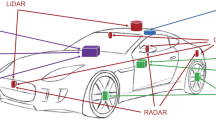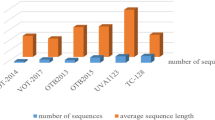Abstract
A novel networked data-fusion method is developed for the target tracking in wireless sensor networks (WSNs). Specifically, this paper investigates data fusion scheme under the communication constraint between the fusion center and each sensor. Such a message constraint is motivated by the bandwidth limitation of the communication links, fusion center, and by the limited power budget of local sensors. In the proposed scheme, each sensor collects one noise-corrupted sample, performs a quantizing operation, and transmits quantized message to the fusion center. Then the fusion center combines the received quantized messages to produce a final estimate. The novel data-fusion method is based on the quantized measurement innovations and decentralized Kalman filtering (DKF) with feedback. For the proposed algorithm, the performance analysis of the estimation precision is provided. Finally, Monte Carlo simulations show the effectiveness of the proposed scheme.
Similar content being viewed by others
References
Carlson N A. Federated filter for fault-tolerant integrated navigation systems. In: Proceedings of the IEEE Position Location and Navigation Symposium, Orlando, 1988. 110–119
Carlson N A. Federated Square Root Filter for Decentralized Para1le1 Processes. IEEE Trans AES, 1990, 26: 517–525
Li X R, Zhu Y M, Wang J, et al. Optimal linear estimation fusion Part I: unified fusion rules. IEEE Trans Inf Theory, 2003, 49: 2192–2208
Sun S. Multi-sensor optimal information fusion Kalman filter. Automatica, 2004, 40: 1017–1023
Zhou J, Zhu Y, You Z, et al. An efficient algorithm for optimal linear estimation fusion in distributed multisensor systems. IEEE Trans SMC Part A: Systems and Humans, 2006, 36: 1000–1009
Luo Z Q. Universal decentralized estimation in a bandwidth constrained sensor network. IEEE Trans Inf Theory, 2005, 51: 2210–2219
Ribeiro A, Giannakis G B. Bandwidth-constrained distributed estimation for wireless sensor networks Part I: Gaussian case. IEEE Trans Signal Process, 2006, 54: 1131–1143
Ribeiro A. Distributed quantization-estimation for wireless sensor networks. Master thesis. Crookston: University of Minnesota, 2005
Ribeiro A, Giannakis G B, Roumeliotis S I. Soi-kf: Distributed Kalman filtering with low-cost communications using the sign of innovations. IEEE Trans Signal Process, 2006, 54: 4782–4795
Msechu E J, Roumeliotis S I, Ribeiro A, et al. Decentralized quantized Kalman filtering with scalable communication cost. IEEE Trans Signal Process, 2008, 56: 3727–3741
You K, Xie L, Sun S, et al. Multiple-level quantized innovation Kalman filter. In: Proceedings of the 17th International Federation of Automatic Control, Seoul, 2008. 1420–1425
Xu J, Li J X. State estimation with quantised sensor information in wireless sensor networks. IET Signal Process, 2011, 5: 16–26
Zhu Y, You Z, Zhao J, et al. The optimality for the distributed Kalman filtering fusion with feedback. Automatic, 2001, 37: 1489–1493
Curry R, Velde W V, Potter J E. Nonlinear estimation with quantized measurements-PCM, predictive quantization, and data compression. IEEE Trans Inf Theory, 1970, 16: 152–161
Doob J. Stochastic Processes. New York: Wiley, 1953. 37
Chong C Y, Mori S, Chang K C. Distributed multitarget multsensor tracking. In: Bar-Shalom Y, ed. Multitarget-Multisensor Tracking: Advanced Applications. Norwood: Atech House. 1990
Max J. Quantizing for minimum distortion. IEEE Trans Inf Theory, 1960, 6: 7–12
Zoghi M R, Kahaei M H. Sensor selection for target tracking in WSN using modified INS algorithm. In: Proceedings of the 3rd International Conference on Information and Communication Technologies: From Theory to Applications, Damascus, 2008. 1–6
Bhardwaj M, Chandrakasan A P. Bounding the lifetime of sensor network via optimal role assignments. In: Proceedings of INFOCOM, New York, 2002. 1587–1596
Xiao W, Zhang S, Lin J, et al. Energy-efficient adaptive sensor scheduling for target tracking in wireless sensor networks. J Control Theory, 2010, 8: 86–92
Author information
Authors and Affiliations
Corresponding author
Rights and permissions
About this article
Cite this article
Xu, J., Li, J. & Xu, S. Data fusion for target tracking in wireless sensor networks using quantized innovations and Kalman filtering. Sci. China Inf. Sci. 55, 530–544 (2012). https://doi.org/10.1007/s11432-011-4533-z
Received:
Accepted:
Published:
Issue Date:
DOI: https://doi.org/10.1007/s11432-011-4533-z




